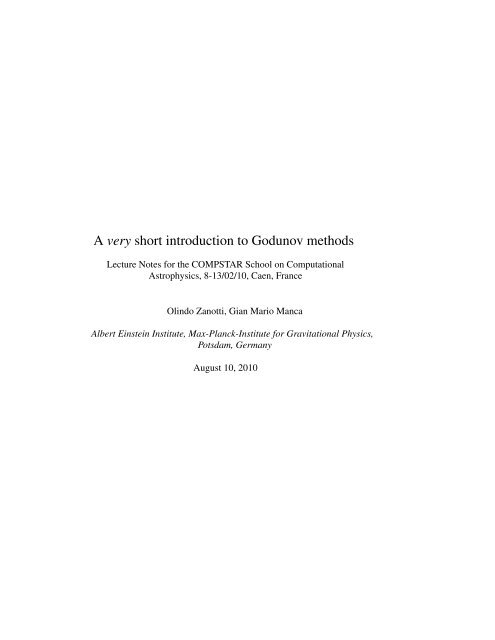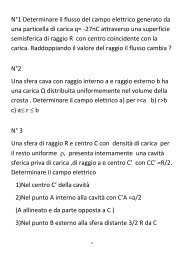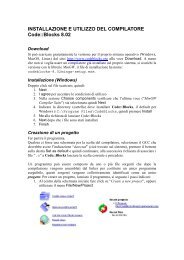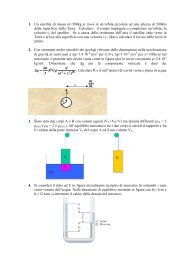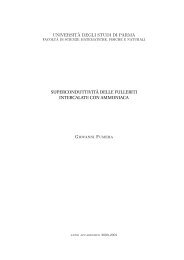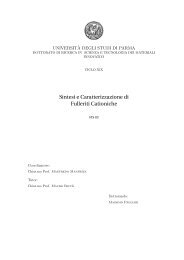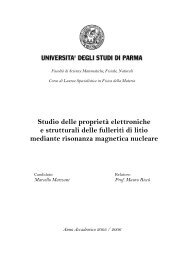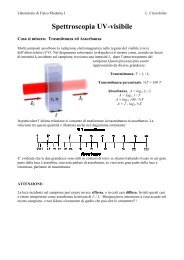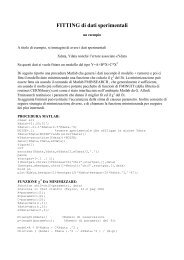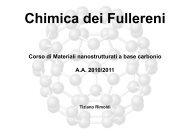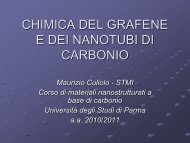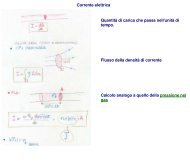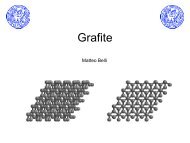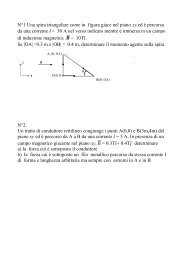A very short introduction to Godunov methods
A very short introduction to Godunov methods
A very short introduction to Godunov methods
Create successful ePaper yourself
Turn your PDF publications into a flip-book with our unique Google optimized e-Paper software.
A <strong>very</strong> <strong>short</strong> <strong>introduction</strong> <strong>to</strong> <strong>Godunov</strong> <strong>methods</strong><br />
Lecture Notes for the COMPSTAR School on Computational<br />
Astrophysics, 8-13/02/10, Caen, France<br />
Olindo Zanotti, Gian Mario Manca<br />
Albert Einstein Institute, Max-Planck-Institute for Gravitational Physics,<br />
Potsdam, Germany<br />
August 10, 2010
Contents<br />
1 Introduction 1<br />
1.1 Conservation form of the 1D Euler equations . . . . . . . . . . . . . 2<br />
1.2 Integral Form of Conservation Laws . . . . . . . . . . . . . . . . . . 2<br />
2 Approximate Riemann solvers for the Euler equations 7<br />
2.1 Approximate State Riemann Solvers . . . . . . . . . . . . . . . . . . 7<br />
2.1.1 “Two-Rarefactions” Riemann Solver . . . . . . . . . . . . . . 7<br />
2.1.2 “All-Shocks” Riemann Solver . . . . . . . . . . . . . . . . . 8<br />
2.2 Approximate Flux Riemann Solvers . . . . . . . . . . . . . . . . . . 8<br />
2.2.1 The HLL(E) Solver . . . . . . . . . . . . . . . . . . . . . . . 8<br />
3 High-Resolution Shock Capturing Methods 11<br />
3.1 Total Variation Diminishing Methods . . . . . . . . . . . . . . . . . . 12<br />
3.2 Reconstruction Procedures . . . . . . . . . . . . . . . . . . . . . . . 12<br />
4 Appendix: Rankine-Hugoniot condition 13<br />
i
Chapter 1<br />
Introduction<br />
A system of equations is in conservative form if it can be written as<br />
with initial and boundary conditions given by<br />
Ut + F(U)x = 0, (1.1)<br />
U(x, 0) = U (0) (x), (1.2)<br />
U(0, t) = UL(t), (1.3)<br />
U(1, t) = UR(t), (1.4)<br />
where U is the vec<strong>to</strong>r of conserved variables, while F(U) is the vec<strong>to</strong>r of fluxes.<br />
U (0) (x) is the initial data at t = 0; [0, 1] is the spatial domain and boundary conditions<br />
are assumed <strong>to</strong> be represented by the boundary functions UL(t) and UR(t).<br />
The use of a conservative form of the equations is particularly important when<br />
dealing with problems admitting shocks or other discontinuities in the solution. A nonconservative<br />
numerical method, i.e. a numerical method in which the equations are not<br />
written in a conservative form, might give a numerical solution which looks reasonable<br />
but is incorrect. A well known example is provided by Burger’s equation, i.e. the<br />
momentum equation of an isothermal gas in which pressure gradients are neglected,<br />
and whose non-conservative representation fails dramatically in providing the correct<br />
shock speed if the initial conditions contain a discontinuity (see Leveque 1992, [8]). As<br />
proved by Hou & Le Floch (1994) [6], non conservative schemes do not converge <strong>to</strong><br />
the correct solution if a shock wave is present in the flow, whereas, as Lax & Wendroff<br />
(1960) [7] showed in a classical paper, conservative numerical <strong>methods</strong>, if convergent,<br />
do converge <strong>to</strong> the weak solution of the problem. On the other hand, it should be<br />
remembered that a conservative formulation and a non-conservative one are equivalent<br />
as long as the solution remains smooth.<br />
1
2 CHAPTER 1. INTRODUCTION<br />
1.1 Conservation form of the 1D Euler equations<br />
The New<strong>to</strong>nian hydrodynamics equations for a one-dimensional, non self-gravitating<br />
fluid<br />
∂ρ ∂(ρu)<br />
+ = 0 , (1.5)<br />
∂t ∂x<br />
∂(ρu)<br />
∂t + ∂(ρu2 + p)<br />
= 0 , (1.6)<br />
∂x<br />
∂E<br />
∂t<br />
+ ∂[u(E + p)]<br />
∂x<br />
= 0 , (1.7)<br />
(1.8)<br />
offer a simple example of a system of equations that can be written in conservative<br />
form like in (1.1) with a vec<strong>to</strong>r of conserved variables given by<br />
⎡ ⎤<br />
ρ<br />
U = ⎣ ρu<br />
E<br />
⎦ (1.9)<br />
and a flux given by<br />
⎡<br />
F = ⎣<br />
ρu<br />
ρu 2 + p<br />
u(E + p)<br />
⎤<br />
⎦ , (1.10)<br />
where E = 1<br />
2 ρu2 + ρɛ is the <strong>to</strong>tal energy, ɛ the specific internal energy. In the case<br />
of the Euler equations the conservative formulation reflects the physical conservation<br />
of specific and well defined quantities, i.e. the mass, the momentum and the energy.<br />
However, for other system of equations it may happen that the conservative formulation<br />
does not reflect any true conserved physical quantity.<br />
1.2 Integral Form of Conservation Laws<br />
Consider a one-dimensional time dependent system described by the Euler equations<br />
written in conservation laws. We can now discretize the spatial domain in<strong>to</strong> N computing<br />
cells Ii = [xi−1/2, xi+1/2] of size ∆x = xi+1/2 − xi−1/2, with i = 1, ..., N.<br />
We also define a “control volume” as V ≡ Ii × [tn , tn+1 ] (see Fig. 1.1).<br />
The integral form of the conservative equations (1.1) on this domain can be written<br />
by first integrating (1.1) in space over Ii<br />
d<br />
dt<br />
xi+1/2<br />
x i−1/2<br />
U(x, t)dx = F(U(x i−1/2, t)) − F(U(x i+1/2, t)) , (1.11)<br />
and then in time between t n and t n+1 , with t n < t n+1 <strong>to</strong> obtain<br />
xi+1/2<br />
x i−1/2<br />
U(x, t n+1 )dx =<br />
xi+1/2<br />
xi−1/2 n+1<br />
t<br />
t n<br />
U(x, t n )dx + (1.12)<br />
F(U(x i−1/2, t))dt −<br />
t n+1<br />
t n<br />
F(U(x i+1/2, t))dt ,
1.2. INTEGRAL FORM OF CONSERVATION LAWS 3<br />
Figure 1.1: Mesh.<br />
which represents the integral form of the equations. At this point we define two new<br />
quantities<br />
U n xi+1/2<br />
1<br />
i =<br />
U(x, t<br />
∆x xi−1/2 n )dt (1.13)<br />
and<br />
such that (1.12) is re-written as<br />
Important remarks:<br />
Fi±1/2 = 1<br />
n+1<br />
t<br />
∆t tn F[U(xi±1/2, t)]dt (1.14)<br />
U n+1<br />
i = U n i + ∆t<br />
∆x (F i−1/2 − F i+1/2). (1.15)<br />
• (1.15) is not yet a numerical scheme. In fact, it has been obtained through mathematical<br />
definitions with no approximations. One should in fact distinguish between<br />
the mathematical formulation of the method, which assumes the knowledge<br />
of the analytic functions U(x, t) and F(x, t), from its numerical application,<br />
which requires an interpretation of the terms entering (1.15) before a<br />
numerical scheme is effectively built.<br />
• (1.15) becomes a numerical scheme, and indeed it is called “<strong>Godunov</strong> scheme”,<br />
when approximation are introduced for the computations of the numerical fluxes<br />
F i−1/2 and an interpretation is given <strong>to</strong> the averages Ui.<br />
• In <strong>Godunov</strong>’s first order method the evolution from the time t n <strong>to</strong> the time<br />
t n+1 = t n + ∆t is obtained by first assuming a piece-wise constant distribution<br />
of the data over the spatial grid, i.e. by assuming that Ui are constant (see<br />
Fig.1.2). Of course, by doing so, part of the knowledge of the original initial data<br />
U(x, t n ) inside the cell is lost, and <strong>to</strong> increase the spatial accuracy a number of<br />
reconstruction procedures has been developed.
4 CHAPTER 1. INTRODUCTION<br />
• Different numerical algorithms can then be devised from (1.15) according <strong>to</strong><br />
the method used <strong>to</strong> calculate the fluxes at each interface, F i−1/2 and F i+1/2.<br />
At the interface between adjacent numerical cells the quantity Ui manifests a<br />
jump, thus generating a sequence of local Riemann problems. Hence, we say<br />
that (1.15) is <strong>Godunov</strong>’s first-order upwind method if the fluxes are calculated<br />
by solving such sequence of local Riemann problems. The left and right states<br />
are the same piece wise constant distribution of data given by (1.13). Solving<br />
the local Riemann problem provides either the term U(x i±1/2, t) <strong>to</strong> be used in<br />
(1.14), or the F[U(x i±1/2, t)] term itself.<br />
• Finally, it should be recalled that the <strong>Godunov</strong> scheme (1.15) with the piece wise<br />
constant distribution of the data is just first order accurate in time and space. This<br />
can be better appreciated if we apply the scheme (1.15) <strong>to</strong> the linear advection<br />
equation with the flux given by F = λU. In this case the solution of each local<br />
Riemann problem at the generic cell interface xi+1/2 is given by Un i , if λ < 0,<br />
, if λ > 0. Therefore, the resulting scheme is given by<br />
and by U n i+1<br />
and<br />
U n+1<br />
i = Un i − c(U n i − U n i−1), if λ > 0, (1.16)<br />
U n+1<br />
i = Un i − c(U n i+1 − U n i ), if λ < 0, (1.17)<br />
where c = λ∆t/∆x is the Courant fac<strong>to</strong>r. The schemes (1.16) and (1.17)<br />
are nothing but the first order upwind method first introduced by Courant et al.<br />
(1952). The spatial accuracy of the first order <strong>Godunov</strong>’s method presented here<br />
can be improved by adopting some kind of reconstruction procedure, while the<br />
time accuracy can be increased by combining the method outlined above with a<br />
conservative Runge-Kutta scheme.<br />
• A final remark about the scheme (1.15) is that the time step ∆t must satisfy a<br />
Courant-Friedrich-Lewy type condition (Courant et al. 1928)<br />
∆t ≤ ∆x<br />
|vn , (1.18)<br />
max|<br />
where v n max denotes the maximum wave velocity 1 present through the computational<br />
domain at time t n .<br />
It should be emphasized that the originality of <strong>Godunov</strong>’s idea consists of the way<br />
an upwind method is obtained for a general nonlinear system of equations. Upwind<br />
<strong>methods</strong>, we recall, are characterized by the fact that the spatial differencing is performed<br />
using grid points on the side from which information flows. If we think of<br />
the advection equation as modelling the advection of a concentration profile in a fluid<br />
stream, then this is exactly the upwind direction. For a linear system of equations, upwind<br />
<strong>methods</strong> can only be used if all the eigenvalues of the matrix F have the same sign.<br />
1Note that in a Riemann problem both shock waves and rarefaction waves are produced, so one has<br />
<strong>to</strong> look for the fastest wave at each time step. In multidimensional problems, when this procedure might<br />
become unsuitable, a common alternative is <strong>to</strong> select vn max as vn max = max(|vn i | + an i ), where vn i is the<br />
flow velocity and an i is the sound speed.
1.2. INTEGRAL FORM OF CONSERVATION LAWS 5<br />
U<br />
i−1 i<br />
i+1<br />
Local Riemann Problem<br />
Interface<br />
Figure 1.2: Schematic representation of a piece-wise constant distribution of a general<br />
quantity U giving rise <strong>to</strong> a sequence of local Riemann problems at the interface<br />
between adjacent cells.<br />
If the eigenvalues have mixed signs, an alternative procedure is often adopted aimed at<br />
identifying the direction of propagation of information on the numerical grid. According<br />
<strong>to</strong> this procedure, the flux F is decomposed in two parts, F + and F − , in such a way<br />
that the corresponding Jacobian matrices F + = ∂F + /∂U and F − = ∂F − /∂U contain<br />
just the positive and negative eigenvalues, respectively, of the original matrix F.<br />
The upwind character of the resulting numerical <strong>methods</strong>, called Flux Vec<strong>to</strong>r Splitting<br />
<strong>methods</strong> (FVS), is thus guaranteed. However, for nonlinear systems of equations the<br />
matrix of eigenvec<strong>to</strong>rs is not constant, and this same approach does not apply directly.<br />
<strong>Godunov</strong> succeeded in obtaining an upwind method in which the local characteristic<br />
structure is not provided by diagonalizing the Jacobian matrix, but rather by solving a<br />
Riemann problem forward in time. The solutions of Riemann problems, in fact, provide<br />
the necessary information about the characteristic structure, and lead <strong>to</strong> conservative<br />
<strong>methods</strong>, since they are themselves solution of the conservation laws.<br />
x
6 CHAPTER 1. INTRODUCTION
Chapter 2<br />
Approximate Riemann solvers<br />
for the Euler equations<br />
<strong>Godunov</strong>’s method, and its higher order modifications, require the solution of the Riemann<br />
problem at e<strong>very</strong> cell boundary and on each time level. This amounts <strong>to</strong> calculating<br />
the solution in the regions that form behind the non-linear waves developing in<br />
the Riemann problem (as shown in Fig. 2.1) as well as the wave speeds necessary for<br />
deriving the complete wave structure of the solution.<br />
The solution of the general Riemann problem cannot be given in a closed analytic<br />
form, even for one dimensional New<strong>to</strong>nian flows. What can be done is <strong>to</strong> find the answer<br />
numerically <strong>to</strong> any required accuracy, and in this sense the Riemann problem is<br />
said <strong>to</strong> have been solved exactly, even though the actual solution is not analytical. In<br />
New<strong>to</strong>nian hydrodynamics, the exact solution of the one dimensional Riemann problem<br />
was found by Courant & Friedrichs (1948).<br />
Approximate Riemann solvers can be divided in approximate State Riemann Solvers,<br />
where an approximation is given <strong>to</strong> the state U(x i±1/2, t) which is then used <strong>to</strong> evaluate<br />
the corresponding flux by (1.14), and in approximate Flux Riemann Solvers, where<br />
an approximation is given <strong>to</strong> the flux directly, thus avoiding the computation of the<br />
state U(x i±1/2, t) at each zone edge.<br />
2.1 Approximate State Riemann Solvers<br />
2.1.1 “Two-Rarefactions” Riemann Solver<br />
Finding the wave pattern in a Riemann problem is part of the solution procedure, but<br />
if one assumes a priori that both nonlinear waves are rarefactions, then the solution<br />
can be obtained analytically (see Toro (1997) for the New<strong>to</strong>nian case and [11] for<br />
the relativistic case). The resulting method is <strong>very</strong> accurate for flow conditions near<br />
vacuum, when rarefaction waves give indeed the best approximation <strong>to</strong> the problem.<br />
7
8CHAPTER 2. APPROXIMATE RIEMANN SOLVERS FOR THE EULER EQUATIONS<br />
Figure 2.1: Riemann problem for the 3D Euler equation: u is the fluid speed, a is<br />
the sound speed. The 1D case can be recovered simply disregarding the tangential<br />
velocities in the y and z direction v and w starting from an initial condition in which<br />
they are zero on both sides of the discontinuity. The variables ρ and p represent density<br />
and pressure respectively.<br />
Figure 2.2: Control volume for the computation of the approximate HLLE flux.<br />
2.1.2 “All-Shocks” Riemann Solver<br />
In analogy with the previous solver, it is possible <strong>to</strong> ignore the occurrence of rarefaction<br />
waves and assume that both nonlinear waves are shock waves. This represents a<br />
good approximation in a wide range of flow conditions, particularly when dealing with<br />
more complicated equations of state than the usual polytropic one (see Colella, 1982).<br />
However, this approach is typically inadequate in the case of a transonic rarefaction,<br />
yielding a numerical solution which does not satisfy the entropy condition.<br />
2.2 Approximate Flux Riemann Solvers<br />
2.2.1 The HLL(E) Solver<br />
In the Riemann solver given by Harten, Lax and van Leer (1983) and later improved<br />
by Einfeldt (1988), ie the HLLE approximate-flux Riemann solver or simply HLLE<br />
Riemann solver, it is assumed that, after the decay of the initial discontinuity of the<br />
local Riemann problem, only two waves propagate in two opposite directions with
2.2. APPROXIMATE FLUX RIEMANN SOLVERS 9<br />
velocities SL and SR, generating a single state between them, i.e.<br />
⎧<br />
⎨<br />
U =<br />
⎩<br />
UL if x/t < SL,<br />
U HLLE<br />
if SL < x/t < SR,<br />
UR if x/t > SR,<br />
where SL and SR are the smallest and the largest of the signal speeds arising from the<br />
solution of the Riemann problem1 .<br />
We will now show how <strong>to</strong> compute U HLLE<br />
. The time integral form of Eq. (1.10 on<br />
the control volume defined in Fig. 2.2 is:<br />
xR<br />
xR<br />
T<br />
T<br />
U(x, T )dx = U(x, 0)dx + F(U(xL, t))dt − F(U(xR, t))dt.<br />
xL<br />
xL<br />
0<br />
0<br />
(2.1)<br />
The evaluation of the right-hand side gives a consistency condition:<br />
xR<br />
xL<br />
U(x, T )dx = xRUR − xLUL + T (FL − FR) (2.2)<br />
where FL = F(UL) and FR = F(UR). Now we split the the integral on the left-hand<br />
side of Eq. (2.1) in<strong>to</strong> three integrals<br />
xR<br />
xL<br />
U(x, T )dx =<br />
T SL<br />
xL<br />
T SR<br />
xR<br />
U(x, T )dx + U(x, T )dx + U(x, T )dx<br />
T SL<br />
T SR<br />
and evaluate the first and third terms on the right-hand side. We obtain:<br />
xR<br />
xL<br />
U(x, T )dx =<br />
T SR<br />
T SL<br />
Comparing Eq. (2.2) with Eq. (2.3) gives<br />
T SR<br />
T SL<br />
U(x, T )dx + (T SL − xL)UL + (xR − T SR)UR (2.3)<br />
U(x, T )dx = T (SUR − SLUL + FL − FR) (2.4)<br />
Dividing by the length T (SR − SL) we finally obtain:<br />
U HLLE<br />
T SR<br />
1<br />
=<br />
U(x, T )dx =<br />
T (SR − SL) T SL<br />
(SUR − SLUL + FL − FR)<br />
(SR−SL).<br />
(2.5)<br />
Thus the integral average of the exact solution of the Riemann problem between the<br />
slowest and the fastest signals at time T is a known constant, provided that the signal<br />
1 The simplest choice is <strong>to</strong> take the smallest and the largest among the eigenvalues of the Jacobian matrix<br />
∂F/∂U evaluated at some intermediate state. For the 1D Euler equation the simplest estimate proposed by<br />
Davis in [12] would be SL = ul − al and SR = ur + ar, where the u’s are the fluid velocities and the a’s<br />
the sound speeds on the left and on the right of the initial discontinuity respectively.
10CHAPTER 2. APPROXIMATE RIEMANN SOLVERS FOR THE EULER EQUATIONS<br />
Figure 2.3: Approximate state for HLLE: the integral average of the exact solution of<br />
the Riemann problem between the slowest and the fastest signals at a given time T is a<br />
known constant, provided that the signal speeds SL and SR are known; such constants<br />
is the right-hand side of Eq. (2.5).<br />
speeds SL and SR are known; such constants is the right-hand side of Eq. (2.5) and we<br />
denote it by<br />
U HLLE<br />
= SRUR − SLUL + FL − FR<br />
(2.6)<br />
SR − SL<br />
We now apply the Rankine-Hugoniot conditions (see Appendix 4) across the left and<br />
the right waves, <strong>to</strong> obtain<br />
F HLLE<br />
F HLLE<br />
= FL + SL(U HLLE<br />
= FR + SR(U HLLE<br />
− UL) (2.7)<br />
− UR) (2.8)<br />
Finally, by replacing (2.6) in<strong>to</strong> (2.7) or in<strong>to</strong> (2.8) we obtain the HLLE flux <strong>to</strong> be used<br />
in the <strong>Godunov</strong> scheme<br />
F HLLE<br />
= SRFL − SLFR + SLSR(UR − UL)<br />
. (2.9)<br />
SR − SL<br />
This Riemann solver, which is <strong>very</strong> simple in its original form, performs well at critical<br />
sonic rarefactions but produces excessive smearing at contact discontinuities due <strong>to</strong><br />
the fact that middle waves are ignored in the solution. Furthermore, it needs <strong>to</strong> be<br />
implemented with an algorithm for the calculation of the wave speeds SL and SR.
Chapter 3<br />
High-Resolution Shock<br />
Capturing Methods<br />
A large effort has been spent in recent years in developing a numerical method able <strong>to</strong><br />
satisfy the following requirements<br />
• at least second order accuracy on smooth parts of the solution,<br />
• sharp resolution of discontinuities without large smearing,<br />
• absence of spurious oscillations e<strong>very</strong>where in the solution,<br />
• converge <strong>to</strong> the “true” solution as the grid is refined.<br />
Irrespective of the Riemann solver adopted, the original <strong>Godunov</strong> method is only<br />
first order accurate on smooth solutions and gives poor approximations <strong>to</strong> shock waves<br />
and other discontinuities. However, if we wanted <strong>to</strong> modify the first order <strong>Godunov</strong><br />
method in order <strong>to</strong> obtain a higher order numerical scheme we would encounter a<br />
fundamental difficulty. Namely, all higher order linear schemes produce nonphysical<br />
oscillations in the vicinity of large gradients. If we define a mono<strong>to</strong>ne linear scheme<br />
of the form u n+1<br />
i = H(un i−l , ..., uni+r ), where H is a linear opera<strong>to</strong>r, as a scheme<br />
for which ∂H/∂un k ≥ 0 for all k, then only mono<strong>to</strong>ne linear schemes do not suffer<br />
from oscillations. Unfortunately, as proved by <strong>Godunov</strong> (1959), mono<strong>to</strong>ne schemes<br />
are at most first order accurate. As a result, higher order linear schemes and absence of<br />
oscillations are two incompatible requirements, forcing the use of nonlinear numerical<br />
<strong>methods</strong>. To summarize: HRSC <strong>methods</strong> result from the combination of <strong>Godunov</strong><br />
type <strong>methods</strong>, which take advantage of the conservation form of the equations, and of<br />
numerical techniques aimed at obtaining second order (or higher) accuracy in smooth<br />
parts of the solution without producing oscillations.<br />
11
12 CHAPTER 3. HIGH-RESOLUTION SHOCK CAPTURING METHODS<br />
3.1 Total Variation Diminishing Methods<br />
The concept of spurious oscillations in the solution can be made more quantitative by<br />
the notion of the <strong>to</strong>tal variation of the solution. The <strong>to</strong>tal variation of a grid function<br />
Q at time level t n is defined as<br />
T V (Q n ) ≡<br />
+∞<br />
i=−∞<br />
|Q n i − Q n i−1|, (3.1)<br />
and is used <strong>to</strong> “measure” the oscillations appearing in a numerical solution. The requirement<br />
<strong>to</strong> have a scheme that is both second (or higher) order accurate and does not<br />
produce spurious oscillations is that the <strong>to</strong>tal variation should not be increasing in time,<br />
so that the <strong>to</strong>tal variation at any time is uniformly bounded by the <strong>to</strong>tal variation of the<br />
initial data. In other words, a numerical method is said <strong>to</strong> be <strong>to</strong>tal variation diminishing<br />
(TVD) if, for any set of data Q n , the values Q n+1 computed by the method satisfy<br />
T V (Q n+1 ) ≤ T V (Q n ). (3.2)<br />
TVD schemes are intimately linked <strong>to</strong> the more traditional Artificial Viscosity <strong>methods</strong><br />
(see Richtmyer & Mor<strong>to</strong>n, 1967), where viscous terms were introduced explicitly in the<br />
scheme in order <strong>to</strong> eliminate or at least control the appearance of the oscillations. In<br />
modern TVD <strong>methods</strong>, on the contrary, artificial viscosity is inherent <strong>to</strong> the scheme<br />
itself in a rather sophisticated way. TVD <strong>methods</strong> do not generally extend beyond<br />
second order accuracy. To construct third (and higher) order <strong>methods</strong> one must drop<br />
condition (3.2) and allow for an increase of the <strong>to</strong>tal variation which is proportional<br />
<strong>to</strong> some power of the typical step size. The resulting <strong>methods</strong> are called Essentially<br />
Non-Oscilla<strong>to</strong>ry (ENO) (see Toro, 1997).<br />
3.2 Reconstruction Procedures<br />
Due <strong>to</strong> the discrete numerical representation, any information about the behavior of the<br />
quantities inside the numerical cell is lost. In order <strong>to</strong> recover in part this information<br />
and improve the spatial accuracy of a numerical code based on Riemann solvers, different<br />
spatial reconstruction procedures have been developed. The common goal is <strong>to</strong><br />
interpolate the profiles of the various thermodynamical quantities within each cell, thus<br />
providing a better estimate for the calculation of the left and of the right state of the<br />
Riemann problem <strong>to</strong> be solved at the interface between two adjacent cells.<br />
Van Leer (1979) was the first <strong>to</strong> introduce the idea of modifying the piece-wise<br />
constant data (1.13) as a first step in achieving higher order spatial accuracy. This approach<br />
has been generically called Mono<strong>to</strong>ne Upstream-centered Scheme for Conservation<br />
Laws (MUSCL). Since then, many other reconstruction procedures have been<br />
developed, such as the piece-wise parabolic method (PPM) of Colella & Woodward<br />
(1984), or the piece-wise hyperbolic (PHM) method of Marquina (1994), where the<br />
interpolation is obtained by using hyperbolae instead of parabolae.
Chapter 4<br />
Appendix: Rankine-Hugoniot<br />
condition<br />
The integral form of Eq. (1.1) on the interval [xL, xR] at time t is<br />
d<br />
dt<br />
xR<br />
xL<br />
U(x, t)dx = F(U(xL, t)) − F(U(xR, t)) (4.1)<br />
We recall a simple formula <strong>to</strong> compute the derivative of an integral:<br />
x2(t)<br />
x2(t)<br />
d<br />
∂f(x, t)<br />
f(x, t)dx =<br />
dx + f(x2(t), t)<br />
dt x1(t)<br />
x1(t) ∂t<br />
dx2(t)<br />
dt − f(x1(t), t) dx1(t)<br />
.<br />
dt<br />
(4.2)<br />
If a discontinuity is present in the solution (see Fig. 2.2) and propagating along s(t) we<br />
can split the left-hand side of Eq. (4.1) in the following way:<br />
d<br />
dt<br />
s(t)<br />
xL<br />
U(x, t)dx + d<br />
xR<br />
U(x, t)dx = F(U(xL, t)) − F(U(xR, t)) (4.3)<br />
dt s(t)<br />
Applying formula (4.2) <strong>to</strong> Eq. (4.3) gives:<br />
s(t)<br />
xR<br />
∂U(x, t) ∂U(x, t)<br />
F(U(xL, t))−F(U(xR, t)) = [U(sL, t)−U(sR, t)]S+<br />
dx+<br />
dx<br />
xL ∂t<br />
s(t) ∂t<br />
(4.4)<br />
where S = ds(t)<br />
dt and U(sL, t) and U(sR, t) are the left and right limit of U(x, t) for<br />
x → s(t).<br />
When xL → s(t) and xR → s(t) the two integrals on the right-hand side of<br />
Eq. (4.4) vanish and we finally obtain the Rankine-Hugoniot condition<br />
F(U(sL, t)) − F(U(sR, t)) = [U(sL, t) − U(sR, t)]S (4.5)<br />
which connects states and fluxes across a discontinuity.<br />
13
14 CHAPTER 4. APPENDIX: RANKINE-HUGONIOT CONDITION
Bibliography<br />
[1] Colella, P., 1982, SIAM J. Sci. Stat. Comput., 3, 76.<br />
[2] Courant, R., Friedrichs, K. O., Lewy, H., 1928, Math. Ann., 100, 32<br />
[3] Courant, R., Isaacson, E., Rees, M., 1952, Comm. Pure Appl. Math., 5, 243.<br />
[4] Einfeldt, B., 1988, SIAM J. Num. Anal., 25, 294.<br />
[5] Harten, A., Lax, P. D., van Leer, B., 1983, SIAM Reviews, 25, 35.<br />
[6] Hou, T. Y., LeFloch, P., 1994, Math. of Comput., 62, 497.<br />
[7] Lax, P. D., Wendroff, B., 1960, Comm. Pure Appl. Math., XVII, 381.<br />
[8] Leveque, R. J. 1992, Numerical Methods for Conservation Laws, Birkhauser<br />
[9] Leveque, R. J., Mihalas, D., Dorfi, E. A., Müller, E., 1998, Computational<br />
Methods for Astrophysical Fluid Flows Saas-Fee Advanced Course 27, Springer<br />
[10] Martí, J.M. & Müller, E. 1994, J. Fluid Mech., 258, 317.<br />
[11] Rezzolla, L. & Zanotti, O. 2001, J. Fluid Mech. 449, 395.<br />
[12] S. F. Davis, SIAM J.Sci.Stat.Comput.,9:445-473,1988<br />
[13] Toro, E. 1997, Riemann Solvers and Numerical Methods for Fluid Dynamics,<br />
Springer.<br />
15


